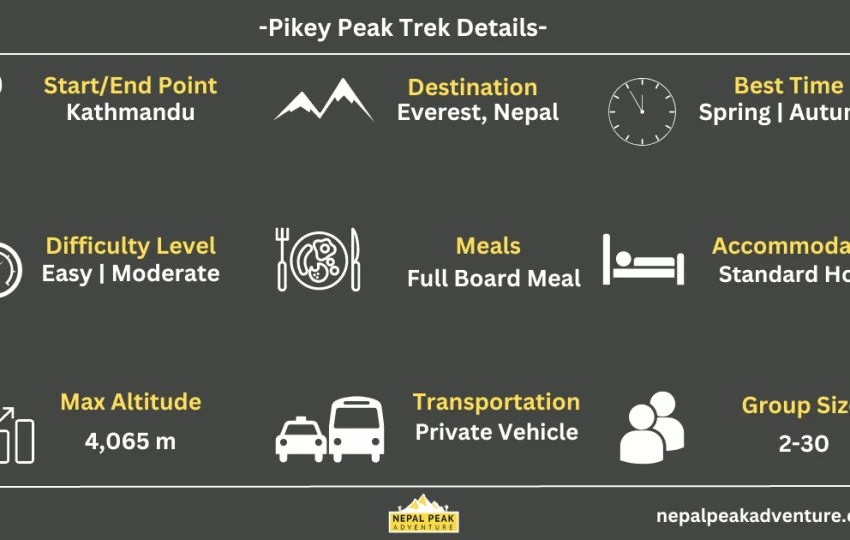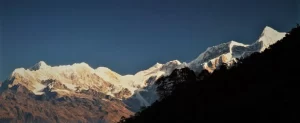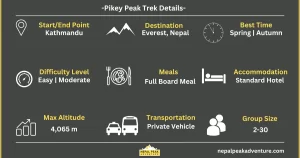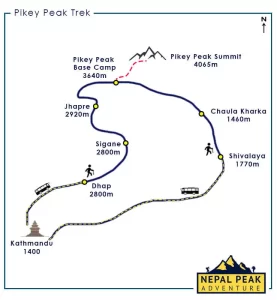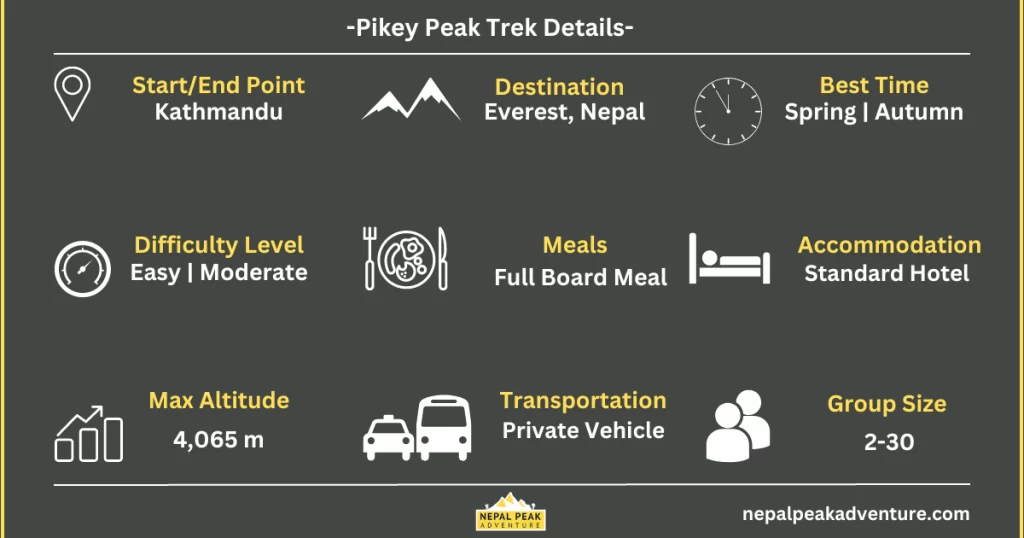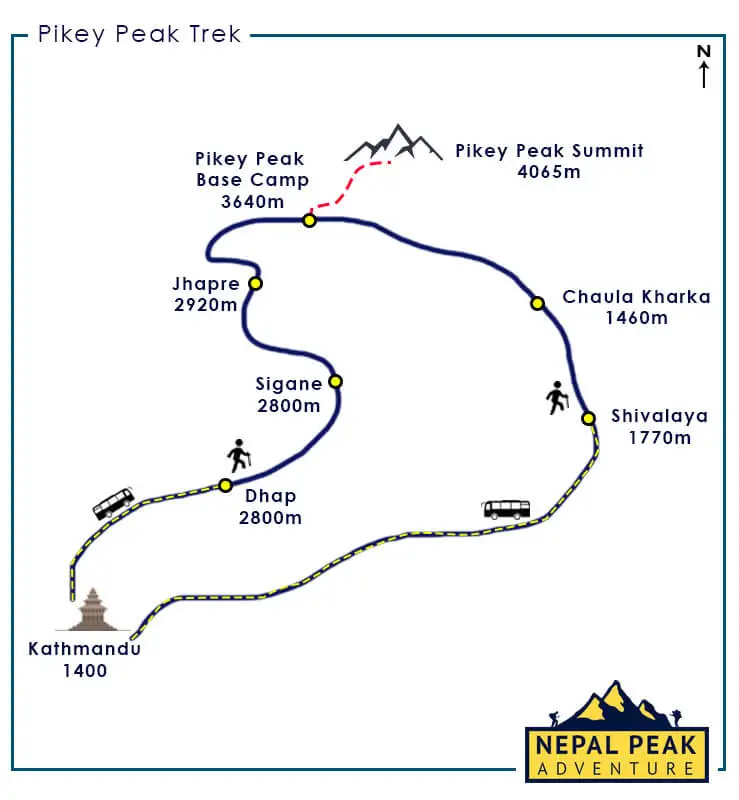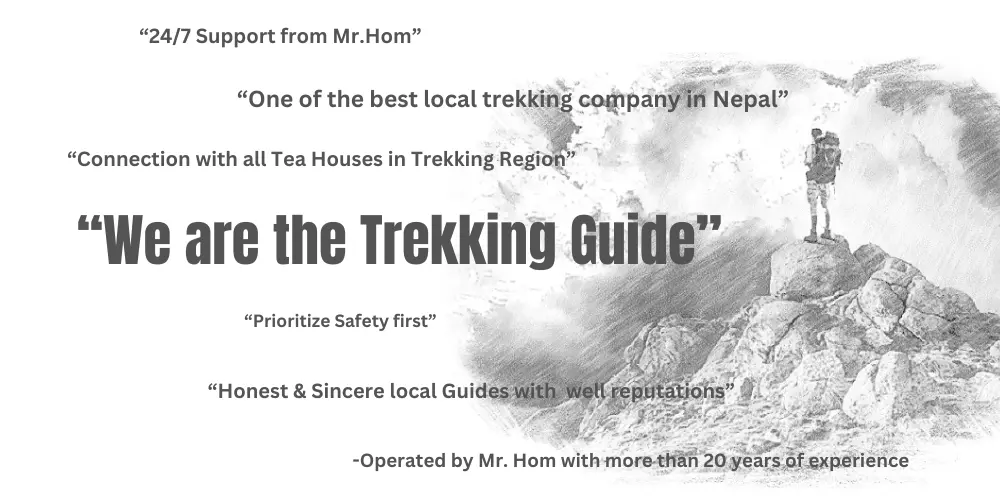Explore the popular & enchanting Pikey Peak (4067m) Trek, a newly introduced trekking trail in the lower Khumbu Region that offers an unparalleled vantage point for witnessing the grandeur of Mount Everest.
The name "Pikey" is derived from the local Sherpa Clan deity, symbolizing the sky over nature, adding a touch of cultural richness to your trekking experience.
Complete the trek through a more leisurely 8-day option, traversing a trail adorned with lush forests of Rhododendron (National Flower of Nepal), Oak, and pine. This scenic journey promises a visual feast, showcasing panoramic views of Everest, Makalu, Annapurna, Gaurishankar, Lhotse, Nuptse, Numbur, Sishapangma, Thamserku, Mera Peak, and Kanchenjunga to the far west.
Noteworthy is the trek's connection to Sir Edmund Hillary, who considered the Pikey Peak Trek his favorite. The route remains a hidden treasure, less traveled by tourists, providing an opportunity for a unique and tranquil experience.
Commencing with a picturesque drive from Kathmandu to Dhap, the journey unfolds amidst stunning views of hillsides, rivers, forests, and farms, culminating in Dhap Bazaar after a scenic drive through numerous settlements.
This trek is more than just a physical challenge; it offers a chance to explore Buddhist sites, including monasteries, gompas, and stupas, adding cultural depth to your adventure. The Pikey Peak Trek, with its accessibility and diverse offerings, stands as a testament to the rich tapestry of natural beauty and cultural heritage in the Khumbu Region.
Interesting Thing About Pikey Peak Trek:
One of the main highlights of the Pikey Peak Trek is the unparalleled panoramic views it offers. As you ascend along the trail, you'll be treated to breathtaking vistas of the majestic Mount Everest, the highest peak in the world, along with other snow-capped summits that adorn the horizon. The sight of these towering giants against the backdrop of the clear blue sky is a sight that will leave you in awe and create memories that last a lifetime.
Beyond the mesmerizing landscapes, the Pikey Peak Trek is also a cultural delight. The route takes you through charming Sherpa villages, where you can immerse yourself in the local way of life and experience the warm hospitality of the Sherpa people.
The Sherpas, renowned for their mountaineering prowess, have a rich cultural heritage that they proudly share with visitors. From their vibrant festivals and traditional ceremonies to their intricate Buddhist monasteries and prayer flags fluttering in the wind, every step of the trek unveils a new facet of their fascinating culture.
What sets the Pikey Peak Trek apart from other treks in the region is its lesser-known status, providing a quieter and more serene experience. Away from the bustling trails of Everest Base Camp and other popular routes, you'll have the opportunity to immerse yourself in nature's splendor without the crowds. This sense of solitude allows for a deeper connection with the environment and a chance to savor the beauty of the Himalayas in its purest form.
Pikey Peak Trek Outline Itinerary:
This Pikey Peak itinerary uses a private vehicle for transportation. Similarly, this Pikey Peak itinerary is designed for all levels of trekkers from amateurs to experts.
- Day 1: Arrival in Kathmandu [1300m]
- Day 2: Drive from Kathmandu to Dhap [2800m] 6-7 hours
- Day 3: Trek from Dhap to Sigane or Jhapre [2920 m] 4-5 hours
- Day 4: Trek from Jhapre to Pikey Base Camp [3640m] 6-7 hours trek
- Day 5: Trek from Pikey Peak Base Camp to Chaula Kharka [1460m] Via Pikey Peak [4065m], 6-7 hours trek
- Day 6: Trek from Chaula Kharka to Shivalaya [1770m] 7-8 hours trek
- Day 7: Drive from Shivalaya to Kathmandu [7 - 8 hours]
- Day 8: Departure Day
Cost Inclusion & Exclusion in Pikey Peak Trek:
Embarking on the Pikey Peak Trek requires careful consideration of the cost involved. Understanding the expenses associated with the trek is essential for planning and budgeting purposes. Let's explore the details of the Pikey Peak Trek cost, including the inclusions, exclusions, value-added services, and the necessary permits and taxes.
Cost Inclusion:
- Welcome dinner with a live Nepali cultural program and a farewell dinner in a reputed Nepali restaurant.
- Includes 2 Nights stay at 3-star standard accommodation in Kathmandu with breakfast.
- Includes accommodation in Teahouse/Mountain Lodge during the whole trek.
- BLD (Breakfast, Lunch & Dinner) during the whole trek
- Experienced Trekking Guide (Licensed Guide, fluent English speaker, first aid and eco trained).
- Sherpa Porter (provided one porter for every two members in a group).
- Trekking permits Charges.
- Any Government and Local body taxes.
- Provision of -30°C cold resistance Down Jacket and sleeping bags (upon request).
- A company Duffle Bag and a T-shirt (as a souvenir).
- Provision of Trekking map and certificate of Trek completion.
- Group medical Kit Box (Includes first Aid kit & will be carried by a Guide)
- Arrangement of the Emergency Helicopter evacuation service which will be covered by your travel insurance company
- Pick-up & Final departure transfer
Cost Exclusion:
- Nepal Visa Costs
- Any International flight cost to Kathmandu and a return ticket from Nepal.
- Any meal at Kathmandu besides Welcome Dinner, Farewell dinner, and Breakfast.
- Cost of any beverages (except hot drinks mentioned in the inclusion list), mineral water and beer, etc. during Trek or in Kathmandu
- Cost for Travel Insurance that must include Helicopter evacuation.
- Tipping to the guide, porter, or any person.
- Anything that is not included in the trip inclusion list.
In addition to the essential inclusions, the Pikey Peak Trek cost often incorporates value-added services that enhance the overall trekking experience. We include:
- Cultural Programs: We offer a welcome dinner with a live Nepali cultural program, offering an opportunity to witness traditional dances, music, and performances that showcase the rich cultural heritage of Nepal.
- Accommodation in Kathmandu: The cost often includes a stay at a hotel in Kathmandu before and after the trek. This provides trekkers with a comfortable and convenient base to rest and prepare for their adventure.
- Trekking Gear Rental: We offer the option to rent trekking gear like a sleeping bag, or down-jacket. This benefits those who do not have their own equipment or prefer not to carry bulky gear on their travels.
Typical Day in the Pikey Peak Trail:
During the Trek, the morning starts with a nutritious breakfast at around 6 or 7 am. Because, the order for breakfast will be noted night before, the teahouse will have it ready on time. Before coming for breakfast at dining hall, we recommend you pack your duffel bag & leave it ready so that porter can pick it up & set off to another destination.
Your Guide will give a short briefing & explain about the trails, difficulty and scenic points of the day. Continuing your trek, you will have a lunch break on the trail most likely at a small village or settlement.
After lunch, the trek continues until your destination where you will spend your night. The dinner will served 6 to 7 pm at dining hall. After dinner, your guide will explain the route & landscape for the next day & take order for your breakfast. Your belongings (bags) will be already in your room and you can have an option to engage in activities like playing cards, sharing stories or go to bed early.
Pikey Peak Trek Map:
A trekking map plays a crucial role in understanding the route and navigating the Pikey Peak Trek. It provides trekkers with a visual representation of the trail, helping them plan their journey and stay on track throughout the adventure. Let's explore the importance of the trek map and delve into the locations covered in this remarkable trek, following a clockwise direction from Kathmandu to Shivalaya.
The Pikey Peak Trek follows a clockwise direction from Kathmandu to Shivalaya. This route ensures a gradual acclimatization process, allowing trekkers to adjust to the increasing altitudes along the way.
Description of the locations covered in the trek
- Kathmandu: The Pikey Peak Trek begins in the vibrant capital city of Nepal, Kathmandu. Trekkers arrive in Kathmandu and spend the first day acclimatizing to the local environment, exploring the city's cultural landmarks, and making any necessary preparations for the trek ahead.
- Dhap: From Kathmandu, trekkers embark on a scenic drive to Dhap, located at an elevation of 2,800 meters. Dhap serves as the starting point of the trek and welcomes trekkers with its rustic charm and picturesque views of the surrounding landscapes.
- Sigane or Jhapre: Continuing along the trail, trekkers make their way to either Sigane or Jhapre, situated at an elevation of 2,920 meters. These quaint villages offer a glimpse into the traditional Sherpa way of life, with their stone houses, prayer flags, and warm hospitality.
- Pikey Base Camp: The journey leads trekkers to Pikey Base Camp, located at an altitude of 3,640 meters. This scenic campsite provides a stunning vantage point to witness the grandeur of Pikey Peak and the surrounding Himalayan range. Trekkers can soak in the awe-inspiring sunrise and sunset views, capturing the beauty of the snow-capped peaks.
- Chaula Kharka: From Pikey Base Camp, trekkers descend to Chaula Kharka at an elevation of 1,460 meters, passing through Pikey Peak, which stands at 4,065 meters. The trail offers mesmerizing views of the landscape, including lush green valleys, terraced fields, and charming villages.
- Shivalaya: The final leg of the Pikey Peak Trek takes trekkers to Shivalaya, situated at an altitude of 1,770 meters. This small settlement marks the end of the trek, where trekkers can reflect on their journey and celebrate their accomplishments before returning to Kathmandu.
Pikey Peak Difficulty and Preparation:
Pikey Peak is classified as an easy to moderate-level difficult trip. Following the route to the lower Everest Region, the highest altitude you will reach in this trek is just 4,065m. However, do not underestimate the route as it contains some challenging steep walks and an average of 5 to 6 hours daily walk which will exhaust you completely. Even though the Pikey Peak trek is best for any amateur or beginner it also requires some good workout program so that you won't get left behind.
I have covered how you can acclimatize and why it is important if you are afraid of altitude sickness during the trek.
Similarly, to prepare for the Pikey Peak trek, you will need good stamina and stamina comes from good Cardio exercises like swimming, running, cycling, hiking, jogging, and many more. Another best way to maintain your physical health is by following a diet plan. Training for a couple of months for the Pikey Peak trek is important.
Similarly, preparation also includes what you should pack for the Pikey Peak Trek. Should you go for expensive gear or practical gear or how you can fully prepare for any worst scenario?
The packing list is categorized as Head wears, Body wears, footwear, and other accessories that will be helpful for your trek. The most basic things that you need to prepare will be listed here and as for the detailed gear planning, you can send us an email including any doubts or covering health problems so that we can suggest some extra gear for you. So, the packing lists are:
- Head Wear includes Hat, Beanie, Sunglass (UV protection), Mask/Buff, Headlight, and earplugs (optional).
- Body Wear should not include any cotton material and should include Down jackets, wind-proof jackets, Warm Gloves, Long-Sleeve T-shirts, Quick Dry T-shirts, Thermal Underwear, Shorts, Gaiters (optional), and Trekking Pants.
- Foot Wear includes full hiking boots, Spare shoes, Sandal/Camp shoes, Woolen hiking socks, cotton socks,
- Other Accessories include Sleeping Bag, med kit (sanitizer, soap, lotion, hydration salts, oximeters), water purifier, Wet wipes, water bottles, water bladder/Hot bag, trekking pole, portable charger, books or cards, nostril openers, Trekking bag(20-25ltr).
You don't have to bring all the items listed on the packing lists because most of them are available to rent or buy in Kathmandu. During the trek, you will only need to carry up to 5-10 kg load while other loads will be carried by a porter. To adjust your carrying capacity, slightly increase your load when training for the Pikey Peak trek.
Conclusion and Final Tips:
The Pikey Peak Trek offers a unique and unforgettable adventure in the lower Khumbu Region of Nepal. With its panoramic views, cultural experiences, and relatively shorter duration, it presents trekkers with a wonderful alternative to other popular treks in the Everest region. Here are some key takeaways and final tips to ensure a successful Pikey Peak Trek:
- Breathtaking Panoramic Views: The trek to Pikey Peak rewards trekkers with magnificent panoramic views of Mount Everest and other snow-capped summits. The route takes you through stunning landscapes of rivers, hills, and expansive pasture fields, offering a visual feast for nature lovers and photography enthusiasts.
- Cultural Experiences: Along the trek, you'll have the opportunity to immerse yourself in the rich Sherpa culture. Interact with the warm and friendly Sherpa people, learn about their traditions and way of life, and witness their colorful festivals and rituals. These cultural encounters add a meaningful dimension to your trekking experience.
- Short Duration: The Pikey Peak Trek can be completed within a relatively short period of time, typically less than a week. This makes it a great option for those with limited time constraints, allowing them to enjoy a rewarding trekking experience without an extended commitment.
Before embarking on the Pikey Peak Trek, it is important to consult healthcare providers and fitness professionals. While the trek is classified as an easy to moderate-level difficulty, proper physical preparation is still necessary. Engage in regular cardio exercises, such as swimming, running, or hiking, to improve your stamina. A well-balanced diet and hydration are also crucial for maintaining optimal physical health during the trek.
Additionally, ensure that you have the appropriate gear and equipment for the trek. Follow the suggested packing list and consider renting or purchasing any necessary items in Kathmandu. Be prepared for changing weather conditions and pack accordingly.
Finally, if you have any doubts or specific concerns, don't hesitate to reach out for further assistance or personalized recommendations.
Embarking on the Pikey Peak Trek promises a memorable and rewarding experience. From the breathtaking views to the cultural encounters, this hidden treasure of the Khumbu Region offers a unique perspective on the Everest region. So, lace up your boots, pack your bags, and get ready for an adventure of a lifetime in the stunning Himalayas.
FAQ
Q: Which season is best for the Pikey Peak Trek?
A: The best seasons for the Pikey Peak Trek are spring (March to May) and autumn (September to November). These seasons offer stable weather, clear skies, and moderate temperatures, making it ideal for trekking and enjoying panoramic views.
Q: What is the altitude of Pikey Peak?
A: Pikey Peak stands at an altitude of 4,065 meters (13,335 feet) above sea level. It provides trekkers with a stunning viewpoint to admire the majestic Himalayan range, including Mount Everest.
Q: Where is Pikey Peak located?
A: Pikey Peak is located in the lower Khumbu Region of Nepal, specifically in Solu-Khumbu District. It is part of the Everest region and offers a unique and less crowded trekking experience compared to popular routes like the Everest Base Camp Trek.
Q: What is the difficulty level of the Pikey Peak Trek?
A: The Pikey Peak Trek is classified as an easy to moderate-level trek. While it does involve some steep walks and daily average walking hours of 5 to 6, it is suitable for trekkers of various experience levels. With proper physical preparation and acclimatization, most adventurers can successfully complete the trek and enjoy its breathtaking landscapes and cultural experiences.

